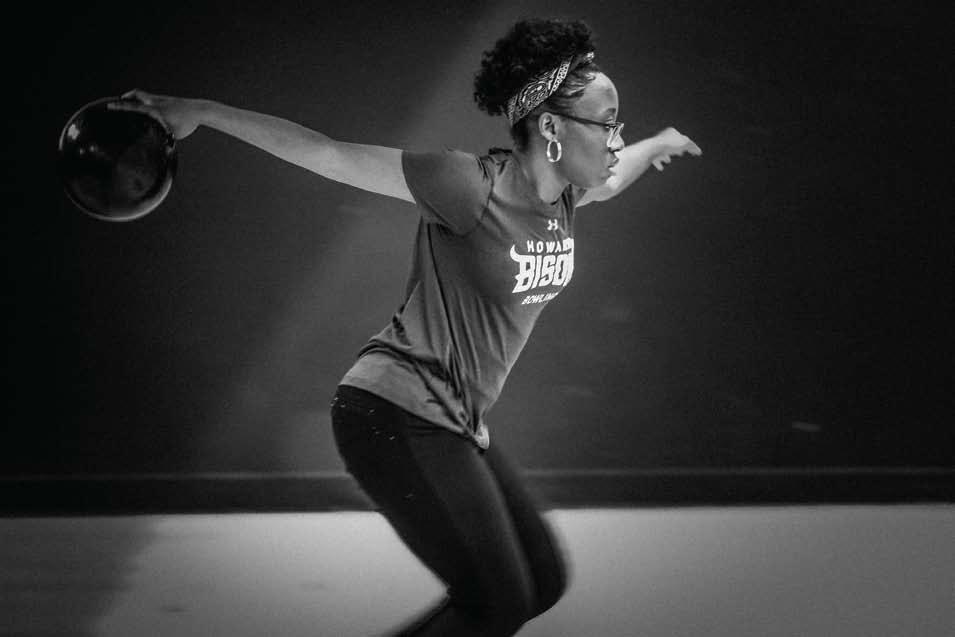
8 minute read
SPORTS
Jayla Webster
Up Their Alley
Advertisement
Howard University’s women’s bowling team wants people to know it exists and it’s here to win.
By Kelyn Soong
@KelynSoong In the decade and a half Ron Davis has spent coaching the Howard University women’s bowling team, he’s never led a group quite like the one he did last winter. The Bison won a program-best 50 matches and qualified for the Mid-Eastern Athletic Conference tournament for the second straight year. The players spoke excitedly about the chance to bowl for the title to cap off their historic season.
Then, shortly before the team was set to leave for the MEAC championships in Chesapeake, Virginia, in late March, the conference suspended its basketball and bowling tournaments and spring sports season due to the COVID-19 pandemic.
Don’t ask Davis about the disappointment he felt. It still stings.
“After you hang up the phone, I’m probably going to knock the wall down or something,” he says with a laugh. “I knew that this team was going in the direction where we could compete in the championship.”
Howard women’s varsity bowling, which has never won the MEAC championship in the 20 years the tournament has been held, will have to wait a little longer before it gets another chance. In November, the school’s athletic department decided to opt out of the 2020-21 season, a call the school “made with the health and safety of our student-athletes being our top priority,” a Howard athletics department spokesperson says.
The bowlers are eager to return, but beyond that, they want respect. They want the recognition that comes with being a Division I collegiate athlete. These women practice daily, yet some classmates are still surprised to learn Howard even has a varsity bowling team. Awareness in the greater D.C. community is even fainter.
Davis intends for that to change.
“We put in the time,” he says. “We’re serious about what we do.” It’s a little after 4 p.m. on March 2, 2020, and I am at AMF Capital Plaza Lanes in Hyattsville to report on the team for a cover story that would eventually be scrapped due to the pandemic. Davis, who is Ron’s son and the team’s volunteer assistant coach, and I wait near the far left corner of the building as Ron, five of the team’s six players, and their team manager enter the facility one at a time.
Since the Howard women’s bowling team does not have its own facility on campus, the players have to commute from D.C. to either Hyattsville or the bowling center at Joint Base Andrews four times a week for practice. There used to be a 12-lane bowling alley at the Armour J. Blackburn University Center on campus, but the lanes have been shut down for renovations since the 2016-17 academic year.
“It’s frustrating,” says captain Carolyn Williams. “Seeing the improvements the athletic department is making in other areas, it’s really rewarding ... but it is a little frustrating that the center has been down for so long.”
Williams, a Glen Burnie native, comes from a bowling family. She picked up bowling around age 3 or 4 and started competing in local youth leagues shortly after. When her mother Nancy went into labor, her father and brother were at Saturday morning bowling league, Williams says.
In sixth grade, she had to write about a college for a school project, and Williams’ teacher assigned her Howard University. Williams discovered during her research that the school has its own varsity women’s bowling team. She made it her goal to bowl collegiately at the HBCU.
“Howard kinda stayed on my brain after that,” she says. “I did look at other places, but I knew at that moment that I wanted to compete at a DI school. I was looking within MEAC and looked at a lot of schools. Not one of them stood out to me like Howard did.”
The MEAC officially sanctioned women’s bowling in 1999, and prior to the 199697 school year, the conference was the first to secure NCAA sanctioning for women’s bowling by adopting it as a club sport. There are currently 11 teams in the conference, including the three-time NCAA champion University of Maryland Eastern Shore, and a total of 87 NCAA schools have sponsored women’s bowling across the Division I, Division II, and Division III levels. All programs are eligible to compete for the NCAA Division I championship, which was first held in 2004.
Howard has never competed in the NCAA championship, coming closest in 2004, when it finished as the MEAC runner-up. The tournament was scheduled to include 16 teams last year, an increase from 12 in 2019. In 2011, the Bison scored a massive upset win during the regular season over Vanderbilt University, then the No. 1 team in the country and the eventual NCAA runner-up.
“In some ways, I think even with professional bowling, [the sport] is still trying to
gain the respect that I believe it deserves,” Williams says. “Same thing for bowling collegiately, not just here at Howard. Bowling is one of those sports [where] you have to constantly defend yourself, even though the respect is there, I think there will still be a fight.”
On this early March afternoon, Williams and Janae Bradford are sidelined with injuries. Senior Tea Lewis is in class. The remaining members, sophomores Jayla Webster and Jahnia Phillips and freshman Vanessa Johnson, start doing jumping jacks to warm up, followed by arm and wrist stretches.
The players line up for the “no step” drill, standing at the foul line and tossing the ball down the lane without taking any steps. “Train your eyes and body to do the same thing,” the younger Davis instructs.
When the team isn’t at a bowling center, the bowlers also put in time in the gym, working on balance drills, doing lunges, and working with the medicine ball. The coaches assign a workout schedule that incorporates cardio every other day, either on the bike or treadmill.
“A lot of people don’t think bowling is physical,” Ron says. “But we work out just like everyone else.”
At practice, the players react to throwing strikes with silence. These aren’t your weekend birthday party bowlers. They understand there’s more to bowling than just simply throwing a ball down the lane. You need to understand the oil patterns, whether it’s a standard house shot, where a majority of the oil is located in the middle of the lane, or a spot short, where most of the oil is concentrated on the outer portion of the lane. Collegiate and professional bowlers compete on sport shots, which is considerably more challenging.
During competition, players may need to stand for hours, and tournaments include multiple competitions against several schools on the same weekend. Bowlers require endurance and flexibility in order to put their bodies in the same positions repeatedly.
“People don’t generally think bowling is a sport,” Phillips says. “They don’t see the athleticism that’s shown in sports like football or basketball, but people understand more the technicality, but actually being able to play the lane, steps, release, finger pressure, why people don’t use the same ball ... There are a lot of misconceptions ... Just because we’re not knocked down doesn’t mean that it’s not a sport.” The players are now scattered around the country.
In a normal year, teammates would be seeing each other daily, commiserating over sitting in traffic on their way to the bowling centers and bonding through the grueling practices. The collegiate season would be more than halfway over.
But now, the players are managing their way through remote, online learning. Instead of practicing in bowling centers and on lanes, the team has resorted to makeshift setups with pillows and sheets. The team hasn’t been in the same place since last year’s spring break—Howard announced on March 11 that it would transition to online and remote instruction. Many of them haven’t met their newest member, freshman Aleyana DeBrest, in person.
For long stretches last fall, bowling centers were closed to the public, but the players still needed to practice.
Phillips created her own bowling lane in a spare room at her parents’ home in Elmont, New York. She set pillows against the wall and laid a comforter on the floor. This way, she can work on her ball releases without damaging anything, Phillips explains.
Webster, who lives in Woodbridge, Virginia, rolled bowling balls in her parents’ backyard with her brother, who also bowls collegiately. “There’s like a little hill,” she says. “We would face towards the hill and roll our balls up the hill, so it would just come back down to us.”
She also has an indoor setup in her basement. To emulate a bowling lane, Webster puts a pillow inside a cardboard box that rests against the wall. Leading up to the box are multiple blankets. “Picture a lane,” she says, “but like covers and pillows. We had it set up something like that, and where the pins are set up, that was basically the box.”
Williams, the lone senior on the team this year, hasn’t been inside a bowling center since October. She’s accepted that she’s bowled for the last time as a Howard Bison, and even though the school says that it will give players this season an extra year of eligibility, Williams has plans to attend a different school for her master’s degree.
Her ultimate goal is to bowl at the professional level. It’s what she’s wanted to do since she was in a youth league, but her time as a Howard Bison solidified those aspirations. “Because of COVID, I have to work 20 times harder to get where I want to be, but it’s gonna happen,” Williams says. “I’m gonna speak it into existence. You will see me competing on your TV, professionally.”
Even if that doesn’t happen, she’ll look back at her time at Howard fondly. She captained a team that made program history. She helped the Bison beat higher ranked teams with better resources. She got to compete in her lifelong sport at her dream school.
“It doesn’t get any better than that,” Williams says.















